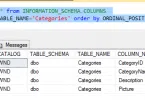In this article, we'll take a look at
Show
Structured Query Language (SQL) is a versatile and powerful programming language that enables users to interact with and manipulate relational databases. Whether you’re a seasoned database administrator, a software developer, or a data analyst, having a strong grasp of SQL queries is essential. In this article, we will explore some important SQL queries that will help you harness the true potential of SQL and make your data operations more efficient.
How many stored procedures have been executed so far and how many times
|
1 2 3 4 5 6 |
SELECT DB_NAME(database_id) DatabaseName, OBJECT_NAME(object_id) ProcedureName,cached_time, last_execution_time, execution_count, total_elapsed_time/execution_count AS avg_elapsed_time,type_desc FROM sys.dm_exec_procedure_stats ORDER BY avg_elapsed_time; |
Kill All the Processes for Any Database
|
1 2 3 4 5 6 7 |
ALTER DATABASE YourDatabaseName SET SINGLE_USER WITH ROLLBACK IMMEDIATE; ALTER DATABASE YourDatabaseName SET MULTI_USER; |
How Many Temporary Tables are Created So Far in SQL Server
|
1 2 3 4 |
SELECT MAX(RIGHT([name],12)) TempTableCreated FROM tempdb.sys.tables |
Validate Email Address in SQL Server
|
1 2 3 4 |
SELECT EmailAddress AS ValidEmail FROM Contacts WHERE EmailAddress LIKE '%_@__%.__%' AND PATINDEX('%[^a-z,0-9,@,.,_,\-]%', EmailAddress) = 0 |
Allow Only Alphabets in Columns
|
1 2 3 4 5 6 7 8 9 10 11 12 13 14 15 16 17 18 19 20 21 22 |
USE tempdb GO -- Create Test table CREATE TABLE TestTable (ID INT, FirstCol VARCHAR(100), CONSTRAINT FirstCol CHECK (FirstCol NOT LIKE '%[^A-Z]%')) GO -- This will be successful INSERT INTO TestTable (ID, FirstCol) VALUES (1, 'SQLAuthority') GO -- This will throw an error INSERT INTO TestTable (ID, FirstCol) VALUES (1, 'SQLAuthority 1') GO -- Clean up DROP TABLE TestTable GO |
Count Week Days Between Two Dates
|
1 2 3 4 5 6 7 8 9 10 11 |
DECLARE @FirstDate DATETIME SET @FirstDate = '2017/07/01' DECLARE @SecondDate DATETIME SET @SecondDate = '2017/07/31' SELECT COUNT(DISTINCT number) FROM master..spt_values WHERE CAST(number AS INT) BETWEEN DATEPART(dy, @FirstDate) AND DATEPART(dy, @SecondDate) AND (DATEPART(dw, DATEADD(d, number, @FirstDate)) IN (2,3,4,5,6)) GO |
Write Case Statement in WHERE Clause
|
1 2 3 4 5 6 7 8 9 10 11 12 13 14 15 16 17 18 19 20 21 |
DECLARE @FirstName VARCHAR(100) SET @FirstName = '' DECLARE @LastName VARCHAR(100) SET @LastName = 'Dave' SELECT FirstName, LastName FROM Contacts WHERE FirstName = CASE WHEN LEN(@FirstName) > 0 THEN @FirstName ELSE FirstName END AND LastName = CASE WHEN LEN(@LastName) > 0 THEN @LastName ELSE LastName END GO |
Get Random Records from Table
|
1 2 3 4 |
SELECT FirstName, LastName FROM [Person].[Person] ORDER BY CHECKSUM(NEWID()); |
Longest-running query in SQL Server with Execution Plan
|
1 2 3 4 5 6 7 8 9 10 11 |
SELECT TOP 10 t.TEXT QueryName, s.execution_count AS ExecutionCount, s.max_elapsed_time AS MaxElapsedTime, ISNULL(s.total_elapsed_time / 1000 / NULLIF(s.execution_count, 0), 0) AS AvgElapsedTime, s.creation_time AS LogCreatedOn, ISNULL(s.execution_count / 1000 / NULLIF(DATEDIFF(s, s.creation_time, GETDATE()), 0), 0) AS FrequencyPerSec ,query_plan FROM sys.dm_exec_query_stats s CROSS APPLY sys.dm_exec_query_plan( s.plan_handle ) u CROSS APPLY sys.dm_exec_sql_text( s.plan_handle ) t ORDER BY MaxElapsedTime DESC |
Introduce Time Delay Between Two TSQL Commands
|
1 2 3 4 5 |
SELECT GETDATE() CurrentTime WAITFOR DELAY '00:00:10' -- 10 Second Delay SELECT GETDATE() CurrentTime |
Hide Store Procedure’s Code so anyone with access
|
1 2 3 4 5 6 7 |
CREATE PROCEDURE EncryptedSP WITH ENCRYPTION AS SELECT 5 AS 'FIVE' GO |
Find all the queries in SQL Server? Can you find it with the help of DMV?
|
1 2 3 4 5 6 |
SELECT dest.TEXT AS [Query], deqs.execution_count [Count], deqs.last_execution_time AS [Time] FROM sys.dm_exec_query_stats AS deqs CROSS APPLY sys.dm_exec_sql_text(deqs.sql_handle) AS dest ORDER BY deqs.last_execution_time DESC |
Script to list all the stored procedures modified in the last 7 days.
|
1 2 3 4 5 6 |
SELECT name, modify_date, create_date FROM sys.objects WHERE type = 'P' AND DATEDIFF(D,modify_date, GETDATE()) < 7 |
Retrieve the Second (or Nth) highest salary of an employee from a table.
|
1 2 3 4 5 6 7 |
SELECT * FROM Employee E1 WHERE (N-1) = ( SELECT COUNT(DISTINCT(E2.Salary)) FROM Employee E2 WHERE E2.Salary > E1.Salary) |
If you may like to know how to optimize SQL queries, please go through the following article: SQL Query Optimize.






Leave a Comment